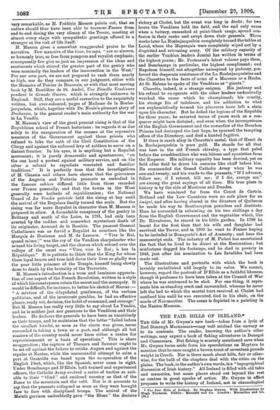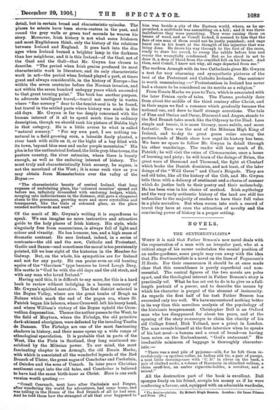THE FAIR HILLS OF IRELAND.* THE title of Mr. Gwynn's
new book—taken from a lyric of Red Donough Macnamara—may well mislead the unwary as to its contents. The reader, knowing the author's other writings, may expeot a book of 'fishing adventures in Donegal and Connemara. But fishing is scarcely mentioned save when Mr. Gwynn turns aside from his speculations on Moytnra to mention that he once caught a brown trout of seventeen pounds weight in Corrib. Nor is there much about hills, fair or other- wise, for the bulk of the chapters deal with the cities on the plains. The book, in the author's own words, is a "topographical discussion of Irish history." All Ireland is filled with old tees and memories, but some places stand out beyond the rest as centres in great epochs of action. Mr. Gwynn in effect proposes to write the history of Ireland, not in chronological
* The Pair Hilts of Ireland. By Stephen Gwynn. With East-rations by Hugh Thomson. Dublin: Kannsel and Co. London: Macmillan and Co.
detail, but in certain broad and characteristic episodes. The places he selects have• been storm-centres in the past, and round the grey walls or green turf mounds he weaves his gory. Moreover, Irish history is not what some Irishmen and most Englishmen think, only the history of the relations between Ireland and England. It goes back into the dim ages when Ireland burned a brighter lamp in the darkness than her neighbour, and it is this Ireland—of the Gael, not of the Gael and the Gall—that Mr. Gwynn has chosen to describe. "The period when Irish genius produced its most characteristic work in literature, and its only characteristic work in art—the period when Ireland played a part, at times great and always considerable, in the history of Europe—lies within the seven centuries before the Norman invasion, and not within the seven hundred unhappy years which succeeded to that great turning point." The book has another purpose, to advocate intelligent travel—travel not merely in wastes where "fine scenery" dear to the tourist-soul is to be found, but travel in the settled parts where history was made in the
old days. Mr. Gwynn is far too deeply cencerned with the human interest of it all to spend much time in ordinary description, though we should rank his picture of Dublin high in that category. He is a little averse to what is called "natural scenery." "For my own part, I see nothing ue- natural in a field growing corn, a lakeside finely planted, a river bank with mills on it, or the bight of a bay filled with
its town, beyond blue seas and under purple mountains." His plea is for the untheatrical Ireland, the little grey-blue towns, the pasture country, the river estuaries, where there is beauty enough, as well as the enduring interest of history. The most truly and characteristically Irish scenery, he argues, is not the moorland of the West ; it is some such view as you may obtain from Monasterboice over the valley of the Boyne
"The characteristic beauty of central Ireland, that long expanse of undulating plain, the 'coloured counties' spread out before sue, infinitely diversified with enclosing hedges, which, merging into indistinctness in the distance, still gave a chequered sheen to the greenness, growing more and more crystalline and transparent, like the tints of coloured glass, as the plain receded northwards and west."
Of the merit of Mr. Gwynn's writing it is superfluous to speak. We can imagine no more instructive and attractive guide to the holy places of Irish history. His style, while singularly free from mannerisms, is always full of light and colour and vivacity. He has humour, too, and a high sense of dramatic contrast. He sees Ireland, indeed, in a series of contrasts—the old and the new, Catholic and Protestant, Gaelic and Saxon—and sometimes the moral is too persistently pointed, till we lose sight of the historian in the Member for Galway. But, on the whole, his sympathies are for Ireland and not for any party. He can praise even an old hunting squire of the "Garrison" type because be loved Lough Derg. His motto is" God be with the old days and the old stock, and
with any man who loved Ireland."
Having said this, it is difficult to say more, for this is a hard book to review without indulging in a barren summary of Mr. Gwynn's spirited narrative. The first district selected is the Boyne Valley, where are the great tombs of Brugh na Boinne which mark the end of the pagan era, where St. Patrick began his labours, where Cromwell left his heavy hand, and where William's victory of the Boyne upheld the Crom- wellian dispensation. Thence the author passes to the West, to the field of Moytura, where the Firbolgs, the old primitive dark-skinned aborigines, were defeated by the invading Teethe de Danann. The Firbolgs are one of the most fascinating shadows in history, and their name opens up a wide range of ethnological speculation. It is probable that in parts of the West, like the Picts in Scotland, they long continued un- subdued by the Milesian power. To our mind, the most fascinating chapter is on Armagh, the old Emain Macha, with which is associated all the wonderful legends of the Red Branch of Ulster, the great sagas of Conchobar and Cuchulain, of Deirdre and the sons of Usnach. In later years Christian sentiment crept into the old tales, and Conehobar is believed to have had the same birth-hour as Christ. Here is one such version worth quoting :—
" Conan Cearnaeh, next hero after Cuchelain and Fergus, after wandering the world for adventures, had come home, and was telling in the House of the Red Branch of all he had seen. And he told them how the strangest of all that ever happened to him was beside a city of the Eastern world, where, as he ap- proached, a multitude was assembling on a hill ; and it was three malefactors they were punishing. They were raising them on beams of wood, and as Conall looked, it seemed to him that the face of one man of them could not be justly punished; and rage burst out in his heart at the thought of the injustice that was being done. He drove his way through to the foot of the cross, ready to draw his sword, to sweep the rabble before him and rescue the wrongfully condemned. But as he stood in act to draw it, a drop of blood from the crucified fell on his breast. And then, said Conall, I know not why, all rage departed from me."
The modern Armagh with its two Cathedrals gives Mr. Gwynn a text for very charming and sympathetic pictures of the best of the Protestant and Catholic Irelands. One sentence is worth remembering :—" Protestantism in Ireland has never had a chance to be considered on its merits as a religion."
From E main Macha we pass to Tara, which is associated with the later Fenian cycle of tales. The Fianna probably date from about the middle of the third century after Christ, and in their sagas we find a romance which gradually became the national one, and drew to itself strange accretions. The tale of Finn and °salmi. and Oscar, Diarmuid and Angus, stands to the Red Branch tales much like the Odyssey to the Iliad. Less
simple and heroic, it is more literary, more subtle, and more fantastic. Tara was the seat of the Milesian High King of Ireland, and to-day its great green ruins among the pasture-lands of Meath show how regal its history has been. We have no space to follow Mr. G-wynn in detail through his other wanderings. The reader will hear much of St.
Patrick; he will visit the ruins of Clonmacnoise, once a home of learning and piety; he will learn of the doings of Brian, the great wars of Desmond and Thomond, the fight at Clontarf which broke the Danish dominion, and not least, of the later doings of the "Wild Geese" and Clare's Brigade. They are sad old tales, like all the history of the Celt, and Mr. Gwynn tells them with a delicacy of sentiment and a charm of manner which do justice both to their poetry and their melancholy.
He has been wise in his choice of method. Irish mythology and the very early authentic history of the land are still too unfamiliar to the majority of readers to have their full value in a plain narrative. But when woven into such a record of travel they have at once the attraction of novelty and the convincing power of history in a proper setting.



































 Previous page
Previous page